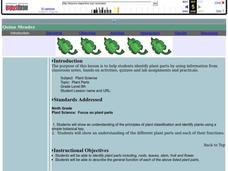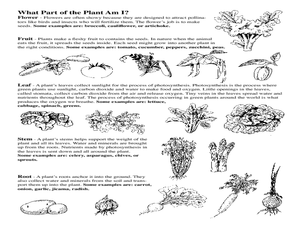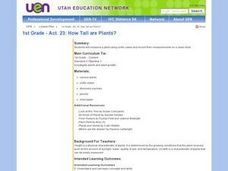Curated OER
Kiwifruit
In this Kiwi worksheet, students watch the America's Heartland video Kiwifruit and fill in the blanks to sentences about it. Students complete 7 sentences.
Curated OER
Fertilizers
Students examine the nutrient makeup in fertilizers. In this plant nutrient lesson students see the effects of common fertilizers on plants.
Curated OER
Plant Parts
Ninth graders identify plant parts by using different classification methods. For this plant lesson students observe and draw different types of leaves then classify them according to species.
Curated OER
Discernment
Students are encouraged to have a sense of the importance of being able to make wise choices. They discuss alcohol abuse and crime and safety. Students comprehend the nature and consequences of anti-social behaviour. They recognize...
Curated OER
Observing Plants Through a Journal
First graders observe a plant, write about it, and illustrate their writing in a journal.
Curated OER
Plant Party
Pupils identify plant parts. In this plants lesson, students bring in a vegetable. Each student classifies which part of the plant their vegetable comes from (flower, root, ect.) Pupils identify the parts of their vegetable and later...
Curated OER
Plants
First graders learn the basic needs of plants, label the major parts of a plant and name their uses. They also use a KWL chart.
Curated OER
Most Troublesome Exotic Invasive Plant Species Web Quest
Students participate in a Web Quest activity in which they identify common exotic invasive plant species of the Southern Appalachian Region. After identifying the top 10 exotic invasive species, they choose one to research in depth.
Curated OER
"Did You Eat That!"
First graders investigate why plants are an important part of our everyday lives, providing us with food, clothing, shelter, etc. In this lesson students participate in a series of hands-on, online, and multimedia activities to examine...
Curated OER
Connections
Students examine the interdependence of the West Central African forest ecosystem. They draw pictures of items found in this ecosystem, discuss their interdependence, and answer discussion questions.
Curated OER
BUS: From Farm to Table (Ag)
Students study about how the world's most important grains and how they are used. They design an ingredient list for the cereal box to be designed in the Marketing Lesson Option #1.
Curated OER
Back to the Farm
Read up on farming and ranching and connect this information to your learners' lives. After reading, send class members home to fill out a family tree and trace their family history, focusing on farming and ranching backgrounds. Once...
Curated OER
IN STRAWBERRY FIELDS
The student will calculate wages of agricultural workers by the hour and by the piece.2. Share background material, and discuss the difference between gross pay and net pay and the difference between getting paid by the hour or the piece...
Curated OER
Earth's Plate Tectonics
Students identify the different layers of the Earth. In this earth science lesson, students create a model of the crusts and continents. They explain how plates movement cause earthquakes and volcanoes.
Curated OER
How Tall are Plants?
First graders measure a plant using unifix cubes and record their measurements on a class chart.
Curated OER
Science: How Tall Are Plants
First graders investigate plant growth and examine what factors contribute to plant growth. They keep a class chart of plant growth and write about and illustrate their conclusions.
Curated OER
Thinning and Transplanting
Students identify and observe one plant per section in their quad and to transplant the surplus seedlings to empty quads and interpret why this is important. They then discuss the purpose of thinning and transplanting. Finally, students...
Curated OER
Observing the Growth Spurt
Students notice a growth spurt in their Brassica plants and closely monitor this growth by measuring their plants and predicting the next day's growth based on the pattern of their data. They also read and highlight the objectives in...
Curated OER
Pack Your Snacks and Go!
In this diet/health worksheet, students complete a word search, finding words related to travel snacks, and read a healthy snack mix recipe. Worksheet is 2 pages, 1 in English and 1 in Spanish.
Curated OER
Harve and Ester's Tree Company
Students examine the role of trees in their lives. They identify products that come from trees and their uses. They are read a book about trees as well.
Curated OER
Lesson: Journey of a Tree
Third graders explore the operation of a Christmas farm and how trees are shipped. After taking a tour of a Christmas tree farm and researching transportation, location and cost issues, 3rd graders create a map to show the distribution...
Curated OER
Vocations: Archdiocese of Cincinnati
Students review virtues lived by the saints. They listen as the teacher describes the process by which a person is named a saint. Students generate a list of gifts and talents, and ways a person could use those talents in a positive,...
Curated OER
Activity #7 Special Properties: A Discussion
Students identify special properties of matter (absorbency, hardness, brittleness, malleability, and elasticity). They define the term matter. Pupils investigate some of the special properties of matter to aid in classifying matter.

























